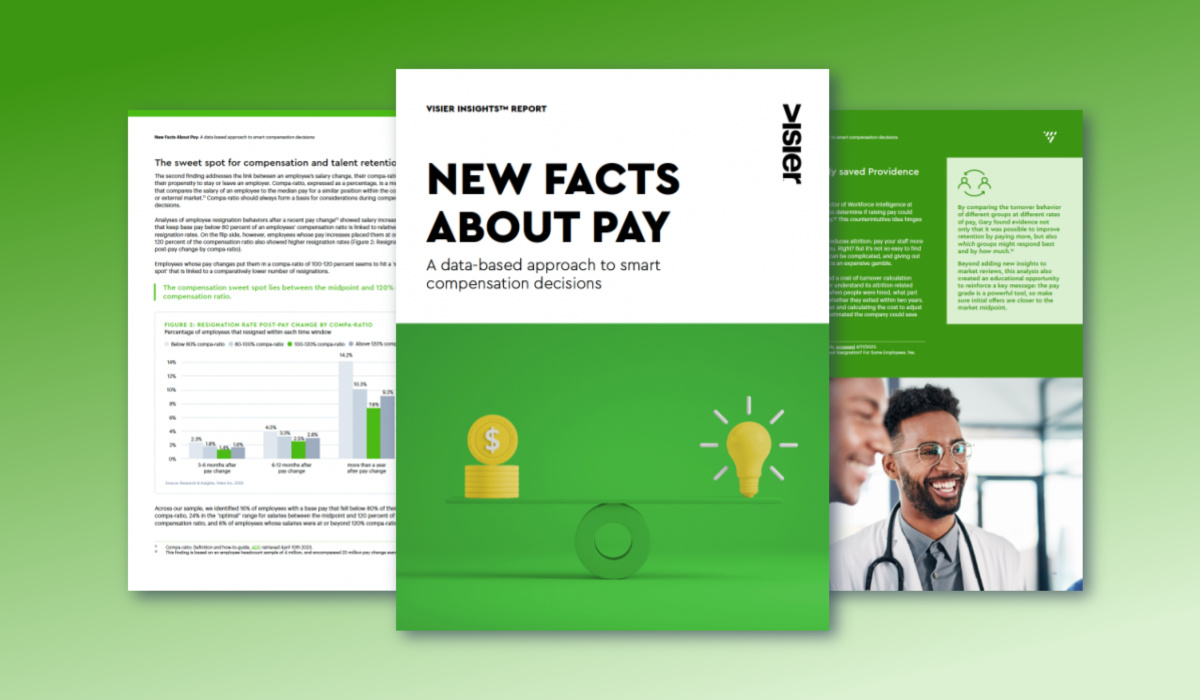COMPENSATION MANAGEMENT
Strategic Compensation: What It Is and How To Create a Plan
A data-driven approach to strategic compensation helps companies create transparent and impactful total rewards programs. Learn more.
Get a demo
Table of contents
What is strategic compensation?Pros and cons of a strategic compensation focusA process for effective strategic compensation planningExamples of strategic compensationMake strategic compensation decisions with people analyticsWhat is strategic compensation?
Strategic compensation is a human resource management technique that helps companies manage total employee compensation. It allows companies to establish reward systems that will increase employee retention and ensure growth, equity, and transparency, while helping businesses save money, stay competitive and boost overall performance.
Strategic compensation also allows companies to establish reward systems that will increase employee retention.
Labor costs on the rise
Labor costs are often the single greatest component of a business’s overall costs, sometimes accounting for as much as 70 percent of overall costs. Given the size of this expenditure and its impact on a business’s overall financial performance, it’s essential for companies to think strategically about their approach to compensation.
Unfortunately, today’s business climate poses a number of challenges for organizations struggling to nail down their compensation strategy.
Strategic compensation challenges
One challenge for organizations today is that the current labor market is decidedly weighted toward the seller. Most workers have significant bargaining power at their disposal compared to employers. This has led to recent spikes in wage growth across the U.S. economy.
At the same time, historic inflation has cut into existing wages. Employees receiving what used to be considered a fairly standard two- or three-percent annual pay increase are actually losing income in real terms, spurring demand for greater pay.
Inflation has also simultaneously had the same effect on employers. Many employers have struggled to pass price increases on to customers. This results in reduced margins and smaller budgets for employee compensation.
The good news is that there are tools available to help employers manage their strategic compensation programs and navigate the treacherous waters of today’s business and labor environment.

Pros and cons of a strategic compensation focus
There are many benefits to a strategic employee compensation focus. There are also some potential drawbacks. These, fortunately, can often be minimized, or even eliminated, through proper planning.
The pros of strategic compensation
Strategic compensation management can have positive ripple effects across your organization—from better planning to improve employee experiences. Here are some of the main pros of strategic compensation.
1. Improved acquisition and retention. One of the most important goals of a strategic compensation program is acquiring and retaining key staff. There are some roles, and employees, that are so critically important to an organization that their loss would be extremely disruptive. Strategic compensation allows organizations to consider how these critical team members need to be compensated to minimize the risk of turnover and talent loss.
2. Improved employee satisfaction and engagement. Fair compensation for work completed is a major contributing factor to employee satisfaction and employee engagement. Fair compensation is a factor of both the type of work being performed and the quality of staff performance. When employees feel that they are being compensated fairly for the work that they do and relative to other employees in similar positions, they are more likely to be satisfied and engaged.
3. Better tracking of the relationship between performance and pay. When a company gives an employee a big raise, does that mean the employee will become even more productive and effective as a matter of course? Is there a measurable link between performance reviews and compensation? These are the types of questions strategic compensation seeks to answer. Using data to evaluate and answer questions like this can help companies ensure that their pay practices are driving desired results.
4. Holistic, strategic approach to compensation. There are many stakeholders when it comes to employee compensation: employees, managers, department heads, the HR team, senior leaders, and the organization as a whole. Each of these stakeholders will have specific opinions, goals, and motivations for modifying compensations for specific team members and groups. Strategic compensation facilitates a more holistic approach to compensation that harmonizes the various objectives of different individuals and groups, helping to clearly define and standardize pay and rewards across roles and departments.

Things to avoid when implementing a strategic compensation plan
Despite these significant strengths, or pros, of strategic compensation, there are also some potential cons to be aware of.
1. Allegations of bias, favoritism, or discrimination. Strategic compensation, by its very nature, involves prioritizing certain key staff over others. This means that two individuals at the same seniority level and tenure may end up earning different wages if one is seen as more essential to the success of the business than the other. This can cause friction and can drive dissatisfaction, and even lead to claims of bias or discrimination. To minimize these risks, it’s important to clearly document these discrepancies along with supporting data—like performance reviews.
2. Disproportionate focus on top performers. Another potential disadvantage of strategic compensation is that the focus often becomes skewed toward top performers. This is understandable, as these top performers are seen as the most important to retain. But top performers, by definition, don’t represent the organization’s workforce as a whole. The compensation strategy needs to apply to the entire organization.
3. Distorted incentives. One of the goals of strategic compensation is to align employee incentives with corporate goals. That often represents a challenge which can lead to distorted incentives that encourage unintended behaviors and priorities.

A process for effective strategic compensation planning
1. Assess the current strategy
Maybe there is no strategy currently. Maybe there is a strategy that doesn’t seem to be particularly effective. Before throwing everything out and starting over, employers should look carefully at their existing compensation strategy, if any, and determine if it can be improved.
2. Gather employee feedback
Employee surveys can be a great way to gauge how satisfied staff are with their compensation and whether they feel it properly incentivizes them. Of course, there will be a tendency for employees to always say they deserve more compensation. But asking them to note how strongly they feel about certain compensation-related statements can help gauge the strength of those sentiments.
3. Conduct industry benchmarking
Understanding what kind of competition competitors are offering is essential to any compensation strategy, especially in a labor market in which employees have many choices of where to work.
4. Document objectives and challenges
After establishing the current state and competitive positioning, it’s now time to document any challenges and shortcomings that exist within the current framework. This will help you identify what milestones and actions are needed to support the overall compensation goals and objectives.
5. Determine available resources
No business has unlimited resources. Most employers will have certain budget constraints that may limit their ability to pay the wages they’d ideally like to pay. While managers also might want to offer their employees phenomenal salaries, bonuses, and benefits, they have to operate within the bounds of what’s realistically possible. Taking steps to clearly determine available resources will help ensure that your strategic compensation plan is both attainable and sustainable.
6. Create a compensation framework
Understanding the current state, the key challenges and opportunities, and available resources, it’s time to build a framework for the new or updated compensation strategy. At first this will likely be very skeletal, but it can be fleshed out over time as new insights emerge.
7. Review for legal and regulatory compliance
Customizing compensation packages for individual employees can result in discrepancies between similarly situated staff members. This often occurs at the point of hire when a prized potential employee is offered more money to come on board, putting them at or above others in similar roles—or even their managers.
Employers should review their compensation strategy with their HR and legal teams to ensure they aren’t running afoul of any anti-discrimination or other employment and compensation laws.
8. Communicate the policy to staff and managers
Before rolling out a policy change that will impact how employees are paid, employers should carefully communicate the changes to staff—and especially managers—so those managers can answer questions from their team members. Companies should also provide opportunities for input from employees that can be monitored over time.
Ideally, communication about compensation policy updates should happen early in the process so that the official rollout of the policy doesn’t come as a surprise. This ensures that employees feel heard and valued, instead of blindsided by a new policy without due context.
9. Implement, monitor, and iterate
As with most major business initiatives, implementing a compensation strategy isn’t something organizations “get right” on their first try. After the policy is put into place, it’s important to continue to monitor its impacts on company objectives (e.g. increased productivity, improved engagement, better-aligned incentives, etc.). Expect to make some adjustments over time based on new data, input, and insights.

Examples of strategic compensation
Many organizations have likely already implemented some form of compensation strategy without necessarily knowing it. These strategies don’t have to be overly complicated to be effective. In fact, many standard compensation practices are based on incentivizing employees to accommodate company objectives.
Here are a few examples:
1. Overtime pay
Overtime pay is legally required for non-salaried workers. But many companies offer compensation above and beyond the legal floor to incentivize staff to work more hours when the need for labor is particularly acute.
A focus on reducing overtime pay might be part of a strategic compensation plan and something that could be readily monitored through organizational data.
2. Profit sharing
Profit sharing often takes the form of bonuses tied to company profits or stock options. The idea is that by sharing the company’s financial success with staff, they’ll be more encouraged to work hard to make the company successful.
Profit sharing might be part of a strategic compensation plan, especially in organizations embarking on new initiatives or focusing on stretch goals as part of their strategic planning process.
3. Education reimbursement
Some companies offer education reimbursement (including student loan repayment) for the sake of an extra perk. Others do so to encourage staff to learn new skills relevant to their job duties.
Employees value learning and development opportunities. Education reimbursement might be part of a strategic compensation plan in organizations particularly hoping to recruit and retain Gen Z professionals, for instance.
4. Performance-based bonuses
The quiet quitting phenomenon involves employees doing just enough to get by without getting fired to collect a paycheck. Performance-based bonuses encourage employees to go above and beyond to receive extra compensation for achieving higher-level goals and objectives.
Performance-based bonuses could be an important element of a strategic compensation plan designed to help the organization achieve milestone objectives.
It’s clear that there are a wide range of options and considerations to keep in mind when developing strategic compensation plans. Data can be an aid here to ensure the decisions being made will have desired impacts on key company outcomes.

Make strategic compensation decisions with people analytics
Strategic compensation can be tricky. The concept is simple enough in theory. However, developing and applying a compensation strategy across dozens, hundreds, or even thousands of employees can be overwhelming for even the most competent HR teams. Fortunately, there are sophisticated tools available to help organizations manage compensation strategy.
With Visier, HR leaders and compensation managers can easily look at comparisons and analyses of employee compensation across job functions, geographic regions, seniority levels, demographics, and employee performance.
For example, Strategic Compensation allows employers to see the connections between compensation and hiring, retention, and productivity. This solution also helps businesses ensure their budgets are directed at the most impactful areas, whether that be top performers, roles with high attrition, or historically underprivileged employee groups.
Be strategic, stay competitive
Strategic compensation also assists with finding the right balance between investment and savings in an organization’s workforce. This solution lets businesses see how much proposed changes to their compensation structure will cost based on projected headcount, or how much they’ll save through reduced turnover and increased productivity.
Strategic compensation is all about aligning employee incentives with business objectives. That might mean creating incentives for employees to work longer hours, achieve aspirational goals or simply keep working for the organization in the face of alternative employment options. Tools like Visier’s Strategic Compensation solution can help organizations develop, implement, and monitor compensation strategies that help the business remain competitive and an attractive place to work.


